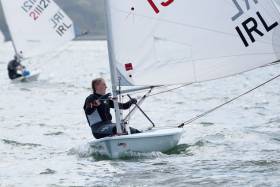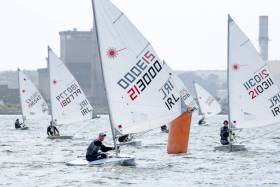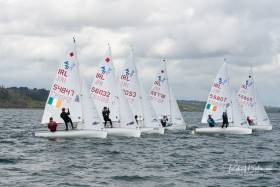Displaying items by tag: youth sailing
Howth Yacht Club's Eve McMahon lies second overall – and first in the under 17 category – going into the final days racing of the ILCA Laser Radial Youth World Championships currently underway in Kingston, Canada.
The 2019 edition of the championships sees 208 competitors from 32 countries competing for World titles in both boys and girls divisions.
Six Irish sailors, four boys and two girls, have made the journey to the 1976 Olympic sailing venue.
McMahon went straight from this month's Youth World Sailing Championships in Poland for the Canadian event.
After 10 races with the final two on Wednesday, some of the Irish sailors are featuring strongly.
A great start for Irish sailors saw both Tom Higgins and Eve McMahon (HYC) top their respective leaderboards after day one.
Subsequent results have seen Higgins drop back to 8th, while McMahon has continued good form and now lies 2nd overall and 1st in the under 17 category.
Clare Gorman (NYC) is in 5th place in the Girls division, while Michéal O’Suilleabhain lies 12th and Eve’s brother Jamie McMahon is in 34th place in the Boys gold fleet.
Full Irish results (after 10 Races)(12 races to complete the regatta)
Girls Gold Fleet:
2. Eve McMahon
5. Clare Gorman (NYC)
Boys Gold Fleet:
8. Tom Higgins
12. Michéal O’Suilleabhain
34. Jamie McMahon (HYC)
Silver Fleet:
51. James Delaney (NYC)
Bronze Fleet:
49. Sam Rutherford
Full results here
Youth Sailing Worlds Conclude in Poland Today
The penultimate day of the 2019 Youth Sailing World Championships in Gdynia, Poland saw three gold medals decided ahead of today’s final races.
Ireland is competing in the boys and girls divisions of both the Laser Radial and the 29er dinghy.
Singlehanded Sibling's Jamie and Eve McMahon from Howth are in the Radial while Leah Rickard and Eimer McMorrow Moriarty and Rian Geraghty McDonnell and Nathan van Steenberge compete in the doublehanded skiff.
It's been a mixed week for this debutante Irish team with some fine individual performances (including a race win for Geraghty McDonnell van Steenberge) but all four found it tough to string a consistent series together. Overall results are here.
There are double celebrations in the 420 fleets tonight after Seb Menzies and Blake McGlashan (NZL) and Madeline Hawkins and Yumi Yoshiyasu (USA) sealed the deal in the Boy’s and Girl’s division with just one race remaining. The Mixed Nacra 15 gold medal was also decided as Will Cooley and Rebecca Hancock (AUS) have an unassailable nine point lead.
All the teams have to do on Friday in their final race is stay out of trouble and avoid a non-discardable disqualification or penalty. The way all three teams have been sailing this week, it’s unlikely any will faulter at the final hurdle and make such a mistake.
The points are significantly closer heading into the final day for the remaining six events with plenty up and downs shaking up the leaderboards.
The Girl’s 420 perpetual RYA Trophy will head to the USA for the third consecutive year after Hawkins and Yoshiyasu picked up from where Carmen and Emma Cowles left off.
Consistency was king for the Americas and going into Friday their lead stands at 22-points. As their highest score is a seventh, they cannot be caught so will walk away as champions.
“We were crying on the way in,” the pair said enthusiastically, “We’re really happy. We’re just going to go out tomorrow and have a solid race but it doesn’t matter because gold is wrapped up.”
They recorded a fourth and a fifth from their two races which was in their game plan. Hawkins commented, “Honestly we were going out there with a mindset to get top seven finishes. That’s all we really needed. We just made sure we could chip off boats and weren’t getting stressed about not being in first or being in 15th. We wanted to be as consistent as possible.”
That steadiness paid off as their rivals had up and down days. The race for silver and bronze will be fierce on Friday as teams from Spain, Germany, Portugal and Argentina are all in contention.
As one of the leading returning teams from the 2018 edition of the Championships, Menzies and McGlashan were touted as potential gold medallists in the Boy’s 420 and they lived up to the billing.
Sitting on 26 points, their discard is a ninth which means that Martin Wizner and Pedro Ameneiro (ESP) cannot catch them on the race course. Only a non-discardable scoreline would see gold slip away.
From the day’s two races, the Kiwis sailed their worst day of the event with a 7-4 but those around them also had mixed days. A fight is on for the remaining podium positions. Teams from Spain, Israel, Italy, Great Britain, Portugal, Poland, Switzerland, USA and Chile all have a chance to claim a medal.
The word consistency is one that is used often in sailing but is an apt word as keeping a consistent scoreline can reap rewards.
Across the week in the Mixed Nacra 15, Australia’s Cooley and Hancock have not won one race but their consistency is unrivalled and they have not finished outside of the top eight once. With one race remaining, they have clinched gold as they hold enough of a points buffer over the French team to confirm the title.
The lead has changed on a daily basis in the Nacra 15 but the Australians prevailed.
Two points separate Titouan Petard and Marion Declef (FRA) and Silas Mühle and Levke Möller (GER) in second and third. It’s not out of the realms of possibility for the chasing teams to overhaul the French and Germans but they would need results to go their way.
Americans Berta Puig and Isabella Casaretto are racing in their second Hempel Youth Worlds in the Girl’s 29er. The pair won silver at the 2018 edition on their home waters and are within touching distance of gold this time round.
They posted a 1-2-1 on Thursday which gives them a 16-point lead over Maltese sisters Antonia and Victoria Schultheis. Two races will follow on Friday and one top eight result will confirm gold.
When asked if their 2018 experience helped them to be in this position, Puig was quick to acknowledge the benefits of going to two in a row, “We already knew what to expect,” she expressed. “This regatta is pretty different and sailing in an all-girls fleet is a different experience. Especially in the US as there aren’t as many girls as we would like but getting the experience last year was very beneficial.”
Their two races wins and a second on Thursday was their most impressive performance of the week and has put them in pole position. On how they sailed so well, Puig said, “It was pretty light at the beginning with about 8 knots out there. It was about staying consistent and making sure that we were on the right shift most of the time, especially on the downwinds. We kept it simple as much as possible.”
Just three points separate the Schultheis sisters and Sweden’s Martina Carlsson and Amanda Ljunggren in second and third.
Much like the Americans, Norway’s Mathias Berthet and Alexander Franks-Penty are well positioned to take Boy’s 29er gold. Two races remain and the Norwegians have an 18-point lead over Ville Korhonen and Edvard Bremer (FIN).
The race for gold will go down to the wire in the Boy’s Laser Radial fleet on Friday. Zac Littlewood (AUS) claimed two seconds on Thursday to remove local hopeful Tytus Butowski (POL) from top spot but just one point splits the pair.
Their discards aren’t comfortable enough for them to match race on the water but fireworks are expected and Butowski will look to draw upon his experience of his home waters to claim a historic gold for Poland.
Italy’s Chiara Benini Floriani has led the Girl’s Laser Radial fleet from start to finish. However, she has not been a runaway leader and it was only after Thursday’s action that she has put some daylight in-between herself and the chasing pack.
Tied overnight on 17-points with Ana Moncada Sanchez (ESP), the Italian finished 12th and second from two races. The Spanish racer could not find her form and was black flagged in the first race before coming through in 12th.
Benini Floriani leads on 31-points followed by the Spaniard on 46, Shai Kakon (ISR) on 47 and Matilda Nicholls (GBR) on 49.
Three races will be sailed in the Boy’s and Girl’s RS:X on Friday. As it stands, Linoy Geva (ISR) is on top of the girl’s division on 29-points followed by Holoise Macquaert (FRA) on 33, Yana Reznikova (RUS) on 34, Natasa Lappa (CYP) on 36 and Julia Matveenko (BLR) on 29.
France’s Fabien Pianazza took three straight race wins on Thursday and has moved two points clear of Nicolo Renna (ITA). The French and Italian sailors have shared nine of ten race victories and will likely fight it out for gold in Friday’s three races.
Leonidas Tsortanidis (GRE) occupies the final podium spot but has Liam Segev (ISR) and Finn Hawkins (GBR) in close company.
Racing is scheduled to commence at the earlier time of 10:40 on Friday 19 July as the 2019 Youth Sailing World Championships concludes.
In the Girls 29er fleet, at the Hempel Youth Sailing World Championships, Ireland's Leah Rickard (National YC) and Eimer McMorrow Moriarty (from Kerry’s Tralee Bay Sailing Club) scored (26.0 UFD), 6.0, 15.0, 22.0 and 43.0 to be 18th from 25 after four races sailed at Gdynia, Poland.
The Irish boys Rian Geraghty McDonnell and Nathan van Steenberge, who won the second race of the championships on Monday, are 16th from 28 with a scoreline of 12.0, 1.0 16.0, 15.0, (28.0) and 22.0.
Maltese sisters Antonia and Victoria Schultheis found the right note at the Hempel Youth Sailing World Championships as the Girl’s 29er fleet commenced their competition.
Having sat ashore waiting to race and subsequently unable to because of minimal breeze on Monday, the Girl’s 29er and 420 fleets, as well as the Boy’s and Girl’s RS:X, finally hit the water for racing and the Maltese sisters shone in the 29er.
Gdansk Bay, just off Gdynia in Poland, was full of the sights and sounds of the 2019 Hempel Youth Worlds, the 49th edition of the prestigious event, and a more stable breeze enabled each fleet to complete a good number of races.
More than 400 sailors from 66 nations are racing on boats supplied by Ovington Boats (Boy’s and Girl’s 29er), Nautivela (Boy’s and Girl’s 420), Laser Performance / Maclaren (Boy’s and Girl’s Laser Radial) and Nacra Sailing (Mixed Nacra 15). The RS:X racers are sailing on their own equipment for 2019. Even to make it to the Youth Worlds is an achievement in itself with only one nation represented in each fleet.
The Schultheis sisters, racing at their second Hempel Youth Worlds together, were models of consistency in the Girl’s 29er. Four races were completed on Tuesday and the pair recorded a (5)-2-3-3 scoreline which positions them at the top of the leaderboard, a point clear of Berta Puig and Isabella Casaretto (USA).
On their day, the sisters commented, almost in unison, “It was super shifty today but the wind increased. We sailed constant and well and are happy with our result.
“It was quite choppy. It was difficult to keep the speed up because sometimes the boat just stopped. We are quite light so it’s a bit easier for us to get over the waves. We’re satisfied with our performance. We were consistent.”
At the 2018 edition of the Youth Worlds in Corpus Christi, Texas, USA, the pair finished a creditable tenth and have understanding of the event and its prestige. They concluded, “We’re really happy but we’re not getting over excited. We’re just going to keep our cool. Our aim was a top five and we’d be happy with that. We just want to have fun.”
Great Britain’s Freya Black and Millie Aldridge are also racing at their second Championships and occupy third place after the opening day. After racing, Black commented, “There’s a lot of good girls here. The Americans, Maltese and Swedish are going to be the ones to watch. There’s more variety here and it’s all to play for. We’re really happy with today.”
The Boy’s 29er added another three races to their overall total. The defending champions Mathias Berthet and Alexander Franks-Penty (NOR) moved up to first overall after a consistent day. They notched up a 3-1-3 scoreline and have moved ten points clear of overnight Ville Korhonen and Edvard Bremer (FIN) who had a mixed day. British racers, Ewan Wilson and Finley Armstrong, occupy third overall.
A win in the second race of the Youth Sailing Worlds in Poland for Ireland's Rian Geraghty McDonnell and Nathan van Steenberge has given the National Yacht Club duo an early boost and leaves them fourth overall after three races sailed.
The Dun Laoghaire duo also scored a 12th and a 16 in their 28-boat fleet at Gydnia yesterday.
In the Girls 29er fleet, Ireland's Leah Rickard (also from NYC) and Eimer McMorrow Moriarty (from Kerry’s Tralee Bay Sailing Club) have yet to race.
Thomas Chaix is coaching the Irish 29ers. Results are here.
The Boy’s and Girl’s 29er, provided by Ovington Boats, are sharing boats in Gdynia. The 28-boat Boy’s 29er were able to complete three races but the Girl’s 29er fleet were unable to race due to dying winds.
 Close racing at the 29er Youth Worlds in Poland where Ireland won race two
Close racing at the 29er Youth Worlds in Poland where Ireland won race two
Finland’s Ville Korhonen and Edvard Bremer got off to a great start, posting a 1-(3)-3 scoreline. "We started well and had good speed," said Bremer, "this put us in the top three all day. It was really shifty and there were a lot of holes in the wind. It built up but it was still challenging."
Korhonen added, "The communication was good today so that helped us most. It’s been a great ever so far, really fun. We’re with the best in the world here."
Spain’s Enrique Urios Salinas and Filippo Binetti Pozzi had a tough start to the competition, sailing their way to a 22nd and a 13th but a bullet in the final race propelled them up the leaderboard.
"We didn’t start as good as we thought we would," commented the Spanish duo. "The conditions were not easy. The wind was really unstable and we couldn’t place where we wanted to place.
"We concentrated a bit more, spoke to our coach and after that we were more focused and did what we were supposed to do. We won the last leg. I think we did really well."
The Spaniards are sixth overall. Defending champions Mathias Berthet and Alexander Franks-Penty (NOR) occupy second and Sweden’s Marius Westerlind and Olle Aronsson are third.
Howth Yacht Club brother and sister, Jamie and Eve McMahon, are the first Irish siblings to qualify for the same Irish Youth Sailing Team and will compete in the Laser Radial class at the Youth Sailing World Championships in Poland in July.
After a successful outing at the RYA Youth Nationals for the first time, report here Rian Geraghty McDonnell and Nathan van Steenberge (National Yacht Club, Dun Laoghaire), with Leah Rickard and Eimer McMorrow Moriarty (Tralee Bay Sailing Club, Fenit) will race in the 29er class.
Eve McMahon achieved her standard in spectacular fashion winning the u17 category at the Europa Cup in Lake Garda last week, as Afloat reported here.
The Youth Sailing World Championships will see over 100 nations compete, and is the world’s leading championship for youth sailors. Ireland first competed in the championship in 1971 and won medals in 1996, 2012, 2014 and 2016.
There will be no Irish 420 crews participating in Poland this year.
Irish Sailing Laser Radial coach Sean Evans will attend and Thomas Chaix will coach the 29ers.
Racing starts 13 July in Gydnia, Poland. More here
There were three McMahon family members from Howth racing in the Laser Radials at this year’s Irish Junior Championship at Crosshaven. But while youngest Jack had to be content with 13th overall, his cousin Eve was very much in improvement mode as the series progressed, notching three fourth places to finish at fifth overall. This made her winner of the girls’ division by five clear points, and thus well entitled to bring the McMahons a second Junior Sailor of the Month accolade for April.
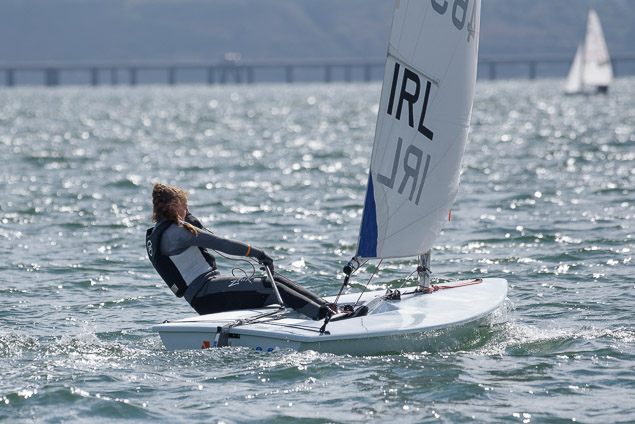 Eve McMahon looking fast in upwind mode Photo: Bob Bateman
Eve McMahon looking fast in upwind mode Photo: Bob Bateman
Jamie McMahon (Howth Yacht Club), put in a convincing performance at the Irish Youth Championships at Royal Cork Yacht Club in the final weekend of April to emerge as Laser Radial overall champion, seeing off some determined challenges from a fleet of 27 from all over the country in a championship contested in decidedly unsettled weather patterns to make him one of two Junior Sailors of the Month for April.
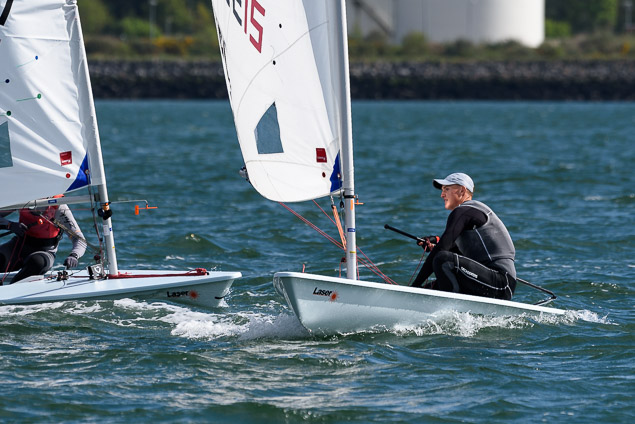 Jamie McMahon negotiates a leeward mark approach Photo: Bob Bateman
Jamie McMahon negotiates a leeward mark approach Photo: Bob Bateman
I like the direct approach of Irish Sailing President Jack Roy. He makes his points clearly, such as telling me that the sport is under pressure from other sports and needs more young people to become involved and ‘yes’ it can be expensive to equip young people to go sailing. But there are ways to do it and he wants to see that happen.
He showed his commitment at the youth championships in Cork Harbour at the weekend, sailed out of the RCYC, Crosshaven, where a hundred and fifty young sailors under the age of twenty raced.
"What about the constant criticism that sailing is an expensive sport?"
“Sailing is under a lot of pressure to attract young people, but we offer a sport that is different and for life and the way to do it is getting children out on the water, so that they can enjoy what it offers".
I asked him: What about the constant criticism that sailing is an expensive sport?
In a direct way, which I have not heard too often previously, he replied: “Sailing and yacht clubs around the country have taken that point and are responding to it. Yes, to set children up in sailing can be an expensive outlay. To counter that, many clubs are investing in their infrastructure and their own boats, so that parents can bring their children down to their local club and, without any massive expenditure, get them on the water by use of club boats, right down to the equipment that is needed. This is what I want to see - access to the sport.”
He also discusses the new initiative in Team Racing.
Jack Roy was on the water during the running of the Youth National Championships and presented the prizes remaining for several while the event organisers wrestled with a problem in the results of the Topper Class. Prizes for Lasers, 420s and Optimists were presented in front of the big attendance, but a few hours later that had considerably diminished when the Topper results were announced, even though the top places had been known from early on. Jack Roy remained to present these prizes, underlining his commitment to young sailors.
There was no explanation for the delay. My information, from very reliable sources, is that the results sheet was blown into the water from the race official boat involved. Days afterwards Irish Sailing would only say that “the results taken from the score sheet submitted by officials were reviewed according to World Sailing rules.”
• Listen to the Podcast interview with the President of Irish Sailing, Jack Roy, below
420 Girls to the Fore Again at the 2019 Youth Nationals at RCYC
The 2019 Irish Sailing Youth National Championships hosted by Royal Cork Yacht Club provided wild oscillations in weather conditions over the four days of planned racing. Thursday was certainly the calm before the arrival of Storm Hanna and three races for the 420 class were completed in light and fickle conditions. Friday dawned with raceable conditions in the morning but the oncoming storm would have provided little opportunity to get on the water and over to the race area and back again before the onset of the strong winds around lunchtime thereby forcing the cancellation of racing. Saturday looked as if it would provide perfect 420 sailing conditions in the strong breeze at the tail end of the storm but a long postponement eventually saw racing eventually cancelled late in the afternoon.
Sunday dawned with fog and no wind, but the fleet launched at 8:30 in the morning to head out to the race course and they were eventually rewarded with a modest breeze in bright sunshine. The Ferguson sisters from the National Yacht Club provided consistency over the two days of racing with five race wins to retain the title again this year after their win in Dun Laoghaire in 2018. In second place with two race wins were another female crew of Lucy Kane and Emma Gallagher followed by Morgan Lyttle and Patrick White in third position.
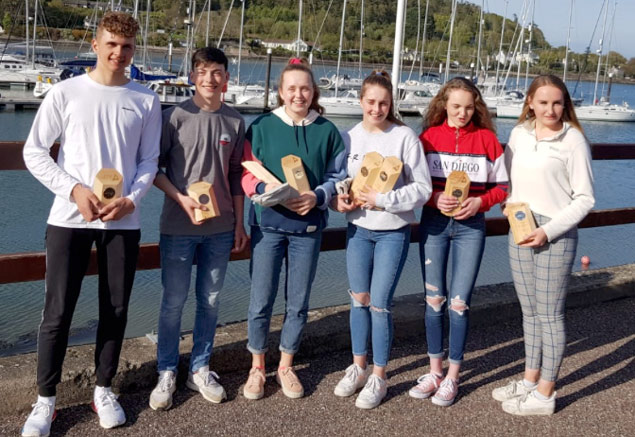 The 420 winning crews at Royal Cork Photo: courtesy Wavelength Images
The 420 winning crews at Royal Cork Photo: courtesy Wavelength Images
The Youth Nationals has traditionally been used by the 420s for team selections to travel to the European or World Championships each year. As Afloat.ie reported earlier here, Nicola and Fiona Ferguson will represent Ireland at the World Championships at Vilamoura in Portugal whilst the qualifiers for the 2019 Junior European Championships at Vilagarcia de Arousa on the North East coast of Spain are as follows:
- Lucy Kane (East Antrim Boat Club) and Emma Gallagher (Malahide Yacht Club)
- Morgan Lyttle Royal (St. George Yacht Club) and Patrick Whyte (Lough Ree Yacht Club)
- Ben Graf and Alexander Farrell (Lough Ree Yacht Club)
Royal Cork Yacht Club and their team of volunteers and race officials are to be congratulated on running a magnificent event under testing weather conditions.
A Howth Yacht Club brother and sister Jamie and Eve McMahon emerged on top of the 200-plus entries at the Irish Sailing Youth Championships sailed in Cork over the weekend in five classes. Both were competing in the single-handed Laser Radial event where Jamie won the class and Eve finished as best girl in fifth overall out of 27 entries.
Prizes were presented this evening on the lawn at the Royal Cork Yacht Club in Cork Harbour.
See photo gallery of prizewinners by Bob Bateman below
 RCYC Admiral Pat Farnan (left), Brian Jones Rear Admiral Dinghies (centre) and IS President Jack Roy
RCYC Admiral Pat Farnan (left), Brian Jones Rear Admiral Dinghies (centre) and IS President Jack Roy There was a fleet of 200 youth sailors for the 2019 Championships at RCYC
There was a fleet of 200 youth sailors for the 2019 Championships at RCYC IS President Jack Roy addresses the sailors
IS President Jack Roy addresses the sailors Justin Lucas, 7th in the Optimist Trials
Justin Lucas, 7th in the Optimist Trials Jessica Riordan, Optimist first girl
Jessica Riordan, Optimist first girl Luke Turvey, fifth in the Optimist trials
Luke Turvey, fifth in the Optimist trials Ben O'Shaughnessy, fourth in the Optimist trials
Ben O'Shaughnessy, fourth in the Optimist trials Sam Ledoux, third in the Optimist Trials
Sam Ledoux, third in the Optimist Trials Rocco Wright, second in the Optimist Trials
Rocco Wright, second in the Optimist Trials James Dwyer Matthews, Optimist Trials winner
James Dwyer Matthews, Optimist Trials winner Eve McMahon, fifth overall and first girl in the Radial
Eve McMahon, fifth overall and first girl in the Radial Chris Bateman, third overall in the Radial
Chris Bateman, third overall in the Radial Micheal O'Suilleabhain, second overall in the Radial
Micheal O'Suilleabhain, second overall in the Radial Emily Riordan, third overall in the 4.7
Emily Riordan, third overall in the 4.7 Alannah Coakley, second in the 4.7
Alannah Coakley, second in the 4.7 Cillian Foster winner of the 4.7
Cillian Foster winner of the 4.7 Morgan Lyttle and Patrick Whyte, third in the 420
Morgan Lyttle and Patrick Whyte, third in the 420 Lucy Kane and Emma Gallagher, second in the 420
Lucy Kane and Emma Gallagher, second in the 420 Nicola and Fiona Ferguson, 420 winners
Nicola and Fiona Ferguson, 420 winners Daniel Palmer, second in the Topper 4.2
Daniel Palmer, second in the Topper 4.2 Peter Doyle, winner of the Topper 4.2
Peter Doyle, winner of the Topper 4.2  Ella Fitzgerald, third and first Topper lady
Ella Fitzgerald, third and first Topper lady
 Lola Kohl third and first lady in the Topper 5.3
Lola Kohl third and first lady in the Topper 5.3
 Oisin Mac Sweeney, second of Topper 5.3
Oisin Mac Sweeney, second of Topper 5.3
 Darragh Collins, first in the Topper 5.3
Darragh Collins, first in the Topper 5.3































